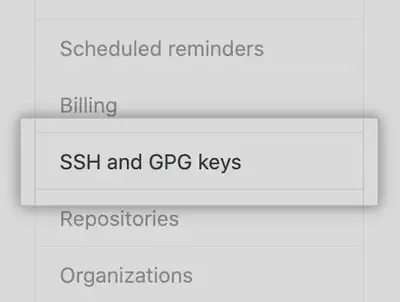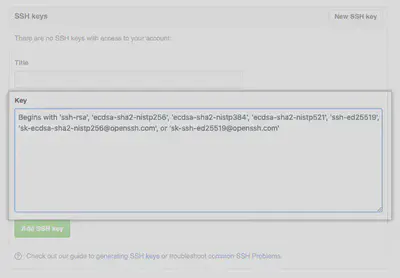Git Configuration
Connecting to GitHub with SSH
You can connect to GitHub using the Secure Shell Protocol (SSH), which provides a secure channel over an unsecured network.
Checking for existing SSH keys
# Lists the files in your .ssh directory, if they exist ls -al ~/.sshGenerating a new SSH key
## -C stands for comment to help identify your ssh key ## -f stands for the file name where your ssh key get saved ssh-keygen -t ed25519 -C "your_email@example.com" -f "github-username"When you’re prompted to Enter a file in which to save the key, press
Enter. This accepts the default file location.> Enter a file in which to save the key (/c/Users/you/.ssh/id_algorithm):[Press enter] At the prompt, type a secure passphrase. For more information, see "Working with SSH key passphrases." > Enter passphrase (empty for no passphrase): [Type a passphrase] > Enter same passphrase again: [Type passphrase again]Ensure the
ssh-agentis running. Start it manually:# start the ssh-agent in the background eval "$(ssh-agent -s)"Add your SSH private key to the
ssh-agent. If you created your key with a different name, or if you are adding an existing key that has a different name, replacegithub-usernamein the command with the name of your private key file.ssh-add ~/.ssh/github-usernameAdd the SSH key to your account on
GitHub.Copy the SSH public key to your clipboard.
# Copies the contents of the id_ed25519.pub file to your clipboard clip < ~/.ssh/github-username.pubIn the upper-right corner of any page, click your profile photo, then click
Settings
In the Access section of the sidebar, click
SSH and GPG keys.
Click
New SSH keyorAdd SSH key.
In the Title field, add a descriptive label for the new key. For example, if you’re using a personal laptop, call this key “Personal Laptop”.💡
Paste your key into the Key field.

Click
Add SSH key.
- While cloning/pulling/pushing code from remote use your username and generated token when prompted for username and password respectively.
- On Windows this stores your credentials in the Windows credential store which has a Control Panel interface where you can delete or edit your stored credentials. With this store, your details are secured by your Windows login and can persist over multiple sessions.
Initialize a new local repository
git init
Developer Configuration
In
Git, there are three main levels of configuration that allow you to control settings at different scopes. These configurations are:- System-level Configuration (
--system)
- Scope: Affects all users on the machine and all repositories.
- Location: The configuration file is stored in the Git system directory, typically located in:
- Linux/macOS: /etc/gitconfig
- Windows: C:\Program Files\Git\etc\gitconfig
- Usage: This is useful for system-wide settings, but it requires administrative access to modify.
git config --system user.name "System Admin"
- Global-level Configuration (
--global)
- Scope: Affects the current user across all repositories.
- Location: Stored in the user’s home directory:
- Linux/macOS:
~/.gitconfigor~/.config/git/config - Windows:
C:\Users\<username>\.gitconfig
- Linux/macOS:
- Usage: This is the most common level for personal settings, like name, email, editor, etc.
git config --global user.name "Your Name"
- Local-level Configuration (
default)
- Scope: Affects only the specific repository in which the configuration is set.
- Location: Stored in the
.git/configfile inside the repository directory. - Usage: Used for repository-specific configurations, such as different credentials, branch settings, or specific hooks.
git config user.name "Repository-Specific Name"
- System-level Configuration (
Gitprovides several options for configuring credentials for every “repo” operations, each with different ways to handle caching or storage.The Git credential
cacheruns a daemon process which caches your credentials in memory for a short period (default: 15 minutes) and hands them out on demand.git config --global credential.helper 'cache --timeout=3600'The Git Credential Manager (
GCM) is a cross-platform, secure way to handle credentials for Git repositories. It integrates with the native credential storage systems on different platforms:- On Windows, it uses the Windows Credential Manager.
- On macOS, it integrates with the macOS Keychain.
- On Linux, it uses the Gnome Keyring or a similar system.
git config --global credential.helper manager
Configure the author name and email address to be used with your commits:
git config --global user.name "LAST_NAME.FIRST_NAME" git config --global user.email "WORK_EMAIL"Normalize your line endings:
git config --global core.autocrlf falseColorized output:
git config --global color.ui autoSetup KDiff as the merge tool:
git config --global --add merge.tool kdiff3 git config --global --add mergetool.kdiff3.path "C:/Program Files/KDiff3/kdiff3.exe"Change the default core editor from vim to VSCode:
git config --global core.editor 'code --wait'Setup proxies to work with Git:
- Option1: Git Proxy without Cntlm: (Not secure as our credentials are being sent “over the wire”)
git config --global http.proxy http://MyUserID:MyPassword@www-proxy.company.com:80 git config --global https.proxy http://MyUserID:MyPassword@www-proxy.company.com:80 - Option2: Git Proxy w/ Cntlm: (Safe since our passwords are encrypted. Generic enough to be used with a host of tools like NPM, Git, AWS, Eclipse, Docker etc.)
git config --global http.proxy http://localhost:3128 git config --global https.proxy http://localhost:3128
- Option1: Git Proxy without Cntlm: (Not secure as our credentials are being sent “over the wire”)
Display current settings
git config --list
Further Read
More info here: http://git-scm.com/docs/git-config